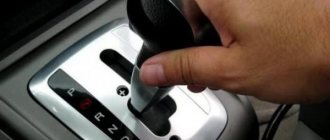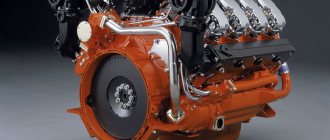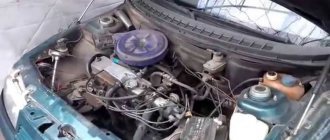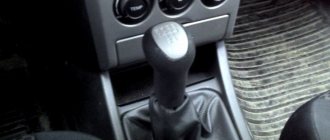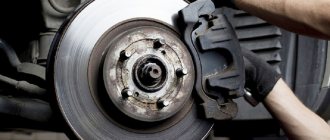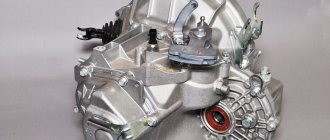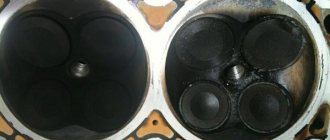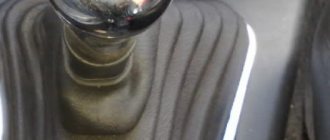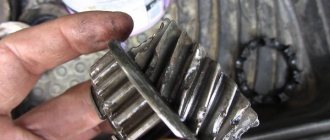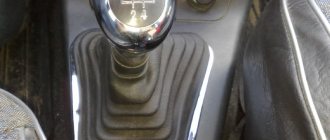Gear shift system - what can break?
It is very likely that the culprit of the chatter will be the lever itself or the system that is used to transmit the translational movements of the lever to the shift mechanism in the transmission. If the rattling occurs only on the lever, but is not transmitted to the entire body, most likely the problem is hidden in this module. If the car does not have a large engine crankcase protection, you can put the car on a lift or drive into a pit and inspect the elements yourself.
The following parts may break:
- seals in the lever itself - just remove the protective covers in the cabin and see what condition the rubber seals and bushings are in, whether there is any play in them, and also evaluate the source of the chatter;
- gear shift lever - in some brands of cars it is made in the form of a complex mechanism and often fails, small plastic bushings wear out and cause vibrations in the lever;
- gear selection fork - this again depends on the design of the car, but very often it turns out to be the cause of the lever rattling in first gear when starting to move, it is more difficult to see;
- connecting elements of the lever and the rocker - usually these are metal tubes with connections that tend to fail over time, so sometimes they need to be revised;
- fastening parts of the rocker - sometimes the device simply unscrews and begins to play, and there may also be problems with engaging some gears, the lever may jam.
These are common causes of lever rattling, but in such a situation the unpleasant sensations will be noticeable not only when driving in first gear. Each touch of the lever will bring unpleasant emotions; you will not recognize the behavior of your car. It will be difficult to find the moment to change gear and find out the correct amplitude of movement of the handle during the trip. Therefore, problems with these nodes need to be eliminated as quickly as possible, without expecting that something else serious and expensive will break.
GEARBOX DEVICE OF THIS MODEL
First, we need to understand why this happens, where the vibration comes from, and why it’s actually not that bad on this particular car. To do this, we need to remember which drive is here and how the engine and gearbox are located. The car is front-wheel drive, so the gearbox is located perpendicular to the direction of travel, that is, the lever in the cabin does not fit directly into the box; a rocker is used. In the classic series with rear-wheel drive, the lever is directly inserted into the box, and if it starts to rattle there, then this is a sure sign of problems with it.
Engine mounts - it’s better to immediately check the integrity
The main element of vibration under the hood is always the power unit and gearbox cushions. Typically, the rear cushion, which holds both the gearbox and the engine, is responsible for lever rattling, but this greatly depends on the design of the car. It is impossible to find a definite answer to the question of how to check pillows yourself. You can watch videos of masters and craftsmen and use their advice, but the fastest way to do this is with the help of specialists at a service station. This is an accurate and quick diagnosis on a lift.
You can check these details yourself like this:
- ask an assistant to get behind the wheel, open the hood, stand in front of the car and give the command to start the engine - if there is strong vibration, there is a problem with the airbags;
- again, ask your assistant to start the car with the hood open, stand on the side of the car and command a smooth start, see if the entire power unit shakes along with the lever;
- with the car turned off, use gloved hands to shake the engine from side to side, it should give in a little, but very moderately; in no case should there be any metallic knocks;
- lift the car onto an overpass or select a convenient diagnostic pit, then use a flat mount to check the quality of fixation of the engine mounts in the lower part and their play;
- in general, listen to the operation of the power unit at idle speed - is there any vibration, is there a knocking or dull tapping when switching to different speed modes.
If at least one of these symptoms is present, you need to start replacing the engine mounts. Doing it yourself is also not advisable unless you have experience. An incorrectly positioned power unit on the cushions will rattle and cause even more problems. It is important to find a specialist who can properly adjust the cushions, set the motor perfectly and test its operation in all modes. This is the only way to hope to fix problems in your car. Otherwise, repairs will only make the situation worse.
Engine speed drops sharply when shifting.
#1 MasikS
Regular visitors Posts: 279
- Car: OPEL VIVARO 2.5CDTI, 2005, G9UB730
- @Mention
#2 uzbek
Experienced Opel Driver
Users Posts: 5,654
- City: Ukraine, Chernivtsi.
- Car: Vivaro 2.5 (2004) G9UB730
- @Mention
Well, look how the speed gain happens in fast mode:
Less intensive acceleration:
Do your rpms drop faster? Maybe you're just not revving the engine enough before shifting?
#3 MasikS
Regular visitors Posts: 279
- Car: OPEL VIVARO 2.5CDTI, 2005, G9UB730
- @Mention
Well, look how the speed gain happens in fast mode:
Less intensive acceleration:
Do your rpms drop faster?
#4 MasikS
Regular visitors Posts: 279
- Car: OPEL VIVARO 2.5CDTI, 2005, G9UB730
- @Mention
#5 ALABAI71
Regular visitors Posts: 565
- City: Ukraine,CHERNIGOV
- Car: vivaro 1.9 F9Q-760 2005
- @Mention
Well, look how the speed gain happens in fast mode:
Less intensive acceleration:
Do your rpms drop faster? Maybe you're just not revving the engine enough before shifting?
In the video, for me, the acceleration is too aggressive; I accelerate much more calmly. I can’t imagine driving like this in the city at all.
#6 uzbek
Experienced Opel Driver
Users Posts: 5,654
- City: Ukraine, Chernivtsi.
- Car: Vivaro 2.5 (2004) G9UB730
- @Mention
Source
CV joint - why could it be the culprit?
Another problem that can cause such unpleasant moments during operation is a breakage of the CV joint on one side. The problem is that this mechanism does not always break, with obvious consequences such as crunching when turning. It is involved in the transmission of torque to the wheels, so it may well result in uneven transmission of this torque and twitching when starting in any gear as a consequence. This is also important to remember when diagnosing problems with such manifestations in the car.
The CV joint is more difficult to check, but you can do the following:
- Turn the wheels on a stationary car all the way and pull the axle shaft with your hand near the entrance to the CV joint; often broken elements will give a play that can be felt without special tools;
- You can also check the CV joints on the go - find a flat area and perform several circles with the steering wheel turned completely to one side, listen for extraneous sounds in the suspension;
- You can also check this element in a pit by carefully examining the boots; most often the CV joints fail when the boot breaks, dirt gets into the mechanism and simply destroys it;
- Service specialists check and give a final verdict on this part only after removal from the installation site, but usually in this case it is better to replace the CV joint with a new one;
- If you are not sure that the problem is in the CV joints, do not rush to change them, check for other reasons, since lever rattling in first gear is not the most likely symptom of their failure.
At the station, with a superficial diagnosis, the hinges may be sentenced to replacement along with the clutch, rocker and other parts. This suggests that the specialist does not want to understand the problem, but wants to make money from you. It is extremely unlikely that all the elements responsible for the possible jerking of the lever in first gear simultaneously fail. If the service station presents a huge list of problems, you will have to find another station and re-diagnosis. In general, this is very important to understand when choosing a specialist to service your car.
WE ELIMINATE VIBRATION
Now you need to carefully inspect the bushing externally, after all, it is precisely because of it that the gearbox lever 2115 rattles. If there is any external damage that is too obvious and signs of wear, then you may have to look for a new part so that you do not have to repeat these manipulations in the future . Now let’s figure out what operations need to be carried out in order to understand how to adjust the rocker on a VAZ 2114:
- We remove the outer plastic braid of the bushing to free its iron body.
- Now we need to see if there are any signs of friction on it. Their presence will indicate that the size is incorrect. They will be especially pronounced if the sleeve is slightly longer than necessary. If this is confirmed, then these extra millimeters are the reasons why the VAZ 2115 gearbox lever rattles. In this case, you need to try on how much excess is in the hole and simply grind it off with a file, usually there are only 1-2 millimeters there.
- Now you need to select some kind of gasket according to the shape of the part, or simply wrap it with electrical tape so that it fits into place more tightly and then does not move.
Clutch is the main, but not the most common element
If you read the opinions of forums on this issue, you will find that it is the clutch that is most often condemned by “armchair experts” in this situation. This is indeed very similar to a broken clutch, but you should check all the above options before repairing or replacing it. You may be able to avoid significant financial investments by eliminating minor problems and eliminating the unpleasant effect of jerking the gearshift knob when starting off. If all else fails, move on to the clutch issue.
Here are some secondary indicators of the breakdown of this mechanism:
- when starting off, you hear a specific smell, especially if you like to drive dynamically, this is the clutch elements burning out, which cannot be restored in any way, they need to be replaced;
- it is impossible to get underway consistently, since the clutch pedal is taken in a new place every time, this is a sign of complete wear of the device, the entire assembly should be replaced or diagnosed;
- slipping is felt, due to which a dip is formed in the process of starting off or switching to another gear, this dip is very noticeable in low gears, less so in higher gears;
- the car is unstable, there may be twitching when releasing the gas pedal in fourth or third speed, and then a jerk when pressing the gas when the car is braking with the engine;
- The car can jerk in other situations, the clutch fails very unpredictably and can bring the most unexpected results in the form of unpleasant manifestations.
If you notice a number of other manifestations, you should immediately begin repairing this unit. Driving with a failed clutch is unsafe, as at some point you may simply not move. It’s good if it’s within the city limits, where you can ask your friends to help or call an inexpensive towing service. If this occurs on the highway, you will have to pay a lot for the evacuation of the car and subsequent repairs at any nearby service center. So such problems should be eliminated immediately.
We suggest watching a video on how to eliminate the beating of the lever when starting:
RPM freezes.
As promised, I am writing a full report on the work done to eliminate the freezing speed. First of all, you can congratulate me, I OVERCOME this disease. If someone doesn’t want to congratulate you, be jealous))) So. Car FF1 Z-tech 2.0 manual transmission. Americans. 152 l/s chip. The timing belt is installed correctly. This report is applicable to other engines and vehicles.
1. Symptoms.
The symptoms are similar to the car of a young lady with the nickname Blonde.
They freeze after acceleration in the range from 2 to 4 thousand, but do not fall in neutral. The error does not appear. The key point
is
NO ERROR
. If there is a “Chek”, then luck is with you for diagnostics and you don’t have to read further.
2. How I searched
2.1.
Naturally I went for diagnostics. In general, in the absence of a “Check engine,” there was no need to go, but like a real Russian, I went through this rake not even two, but four times. The last two times, however, were committed by smart people. Service on Ostozhenka. Although they were not cured, thank you very much for your attitude. They fought twice for four hours. They fought, and not so that there are no mistakes - go and smoke. 2.2. Having fallen into complete f*cks and, as a result, having forgotten all the knowledge that I had, in fact, I learned all this, I began to change everything in a row, fortunately there are several cars in the analysis. Naturally I started with DLDZ and KXX. The result is ZERO. The revs stay the same as before. KXX installed a new one altogether. After changing a bunch of other crap (oxygen sensor, mass meter, throttle valve, spark plugs, wires, coil, camshaft sensor, etc.), removing and installing the intake manifold 5 or 6 times, washing everything that was possible and impossible, I decided that it was time to think about it. 2.3. I thought about it, surfed the forum, re-read this section in full, sympathized with many, laughed at the story about dealers and sports driving, and thought some more. The result is “ZERO”, the speed naturally hangs. I didn’t do anything, I just thought, sympathized and laughed. 2.4. Let's return to the absence of an error
- the conclusion is that the damage is not electronic, the sensors would have detected it and the computer would have seen it. I'm starting to look for mechanics. 2.4.1. Injectors! past - perfect condition. 2.4.2. Throttle and manifold gaskets! I filled the carb with cleaner, took it off and put it back on! 2.4.3. Fuel filter! no comments, pass! But now it's new. 2.4.4. Clutch pedal sensor! I understand that it’s complete nonsense, but I replaced it and missed it! 2.4.5. Fuel pump control unit! On Europeans there is no such thing - and also bypass! Actually the pressure is normal. 2.4.6. Disabled the EGR! There has been progress, the revs still hang, they don’t reach 3000, but they stop somewhere around 2200. 2.4.7. Vacuum booster! I didn’t change it, because if there was a problem with it, then when I pressed the brake pedal, something would change or whistle, but it doesn’t. Past! 2.4.8. Stuck. I went to think.
3. Results of reflection
If the fuel system is not sealed, I’m talking about injectors that are too hot, fuel consumption increases, not speed. Well, of course they can increase, but not to that extent. We exclude the fuel system! The next component in the formation of the fuel mixture is air. If the vacuum connections on the intake manifold are broken, then there is more air, which means the speed is higher. The ECU actually then adjusts it to normal, since it sees that the car is stationary and the throttle valve is closed (by the way, an additional hint that the TPS is normal). Damn, they looked at it at the service center and used carb cleaner, and I looked at it too. BUT still air. There's just nothing left anymore. Because I also managed to connect other brains (ECU).
4.Step to victory.
1. I start the car, warm it up to 100, start pouring water from a huge syringe on all the air connections and run to look at the condition of the exhaust.
2. OPA! Condensate. 3. I'm throwing out the American intake manifold with the USR pipe. I'll put it in European! Hurray, the rpm is 1500, which means there is still some kind of whistle left. I changed a bunch of O-rings on the injectors. 4. I disconnect everything, including the brake vacuum, and plug all the holes. IMPORTANT!
Only plug it with caps or something like a bolt, so that the cap is larger than the hole, otherwise it will be sucked into the engine and you will smile. 5. There is contact! RPM NO LONGER!!!
5. VICTORY!!!
Further manipulations of plugging and unplugging showed that the rubber connection on the tube of the vacuum fuel pressure regulator was still damaged (key words - damaged, tube, connection, vacuum. not key - regulator, fuel). I blew out all the pipes with my mouth. And the funniest thing! The absorber was also damaged (a part that never breaks) or its tube, thick and corrugated with clips (a part that never breaks), was replaced in a heap. I’ll turn it off too, but a little later, because I don’t know yet how to do it correctly. I think the environment will not suffer. The collet of the pipe for the vacuum seal also aroused suspicion, but everything turned out to be normal.
HOORAY!!!
The rpm is 870 if I’m not going anywhere, on the go it’s 1200 in neutral or with the clutch depressed (it seems to be provided by the manufacturer for better pickup, tomorrow I’ll read it somewhere, but if this is not the norm, then I’ll install the old IHC and turn the screws like Valerich)
RESULT
I repeat, if there is an error - FOR DIAGNOSTICS!!!
If there is no error, there is no point in wasting time and money. Don't repeat my mistakes and keep in mind that I didn't spend any money on spare parts. We need to start with something cheap and simple!! Look for damage to all vacuum connections, check the condition of the throttle, wash the throttle and remove it (DO NOT TURN the screws on the throttle) and only then spend money on the VHF, DPS, ECU, ITD, ITP, KMS, DPS, TRATATES, housing and communal services.
P.S. Americans - turn off the USR. The hat is full - it's better without it. There is info on the forum.
and I would also be very glad if this post helped someone!
Let's sum it up
Modern cars rarely provide the owner with surprises in the form of unexpected problems. But domestic budget transport, as well as old foreign cars, very often demonstrate such unpleasant consequences. This may be a consequence of the failure of a small part in the gear shift system, or it may be a consequence of the failure of some complex mechanisms that will cost a lot of money during repairs. In any case, this problem needs to be eliminated. If the lever shakes when starting, other components of the car also receive increased loads. This can cause serious damage that can be expensive to fix.
If you don't know where to start diagnosing, use the four points presented above. The reason for the twitching of the lever when starting to move is usually hidden precisely in them. If this does not help, most likely the problem is hidden in the box itself. This could be a broken tooth on one of the gears or failed fastenings of important parts. It is best to contact a specialist and carry out repairs, but you need a reliable specialist who accurately understands the design of your car. Ask around on forums or with other owners of the same cars if you don’t have a good specialist in mind. Have you encountered such problems on your car?
Disassembly
In order for the vibration of the VAZ 2114 gearbox handle to cease to exist, you need to have a couple of tools in reserve:
- Socket wrenches 13 and 10
- New drawstring cover
- Overpass or pit in the garage
- A smart friend who will help you tune the stick
- You can stock up on thread locker, but you can do without it (this thing is attached to the side of the box itself).
It will take a little time, about half an hour to eliminate troubles and the same amount to adjust.
First way
Progress of the adjustment process:
- Sketch, remember, remove or measure, but make sure that after installation everything is in its place: namely, at a certain distance from the passenger and the console.
- Now you can crawl under the car and begin to unscrew the fasteners for inserting the bushing into the lever tube (also called the rocker) using a 13-socket, and remove the lever.
Backstage VAZ 2114
- Then, remove the cover from the cross. Be prepared for oil to pour out. You can put the container in advance if you really feel sorry for him. Then pour it back. Well, unscrew its fasteners to remove it.
Drawstring without cover for VAZ 2114
- That's it, now we need to install a new clamp - this is the bolt that secures the cross. You can, of course, clean and tighten the old one, but it is not so expensive that you need to save on it. And new things always inspire greater confidence in the future.

